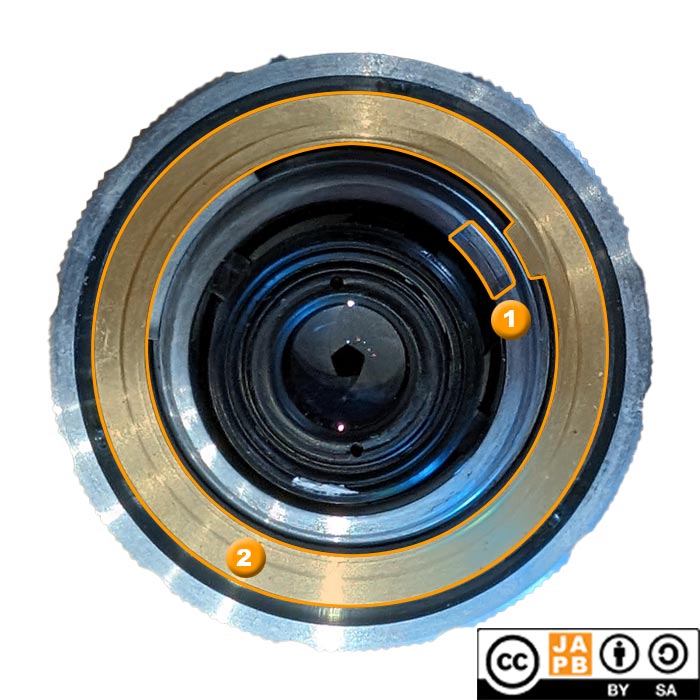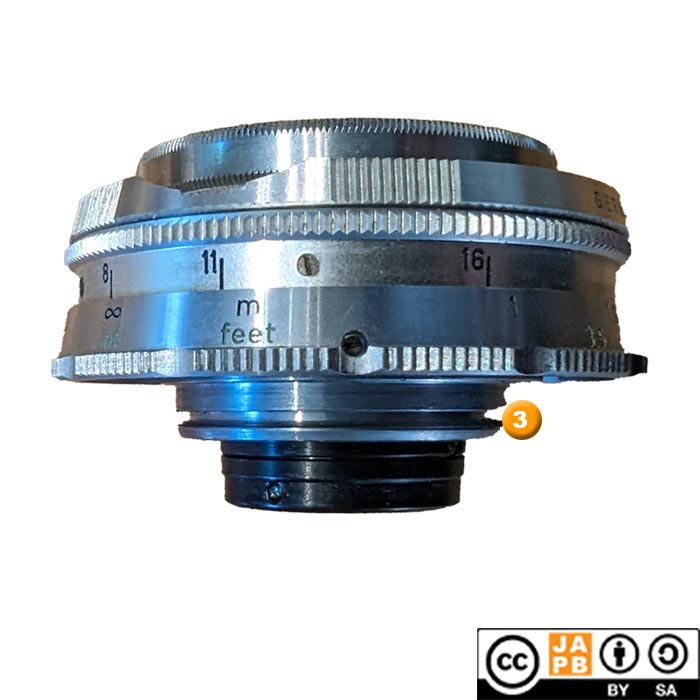Pekka Buttler, August 2024
Introduction
This article is about the lens mount of the Agfa Ambi Silette camera and lenses.
The Agfa Ambi Silette was an interchangeable lens rangefinder camera manufactured by Agfa in Germany between 1957 and 1961. The Ambi Silette was the pinnacle of Agfa’s Silette line of fixed-lens viewfinders and Super Silette fixed-lens rangefinders.
Specifications and identification
Mount type: clamp/bayonet-style hybrid (lens release on camera-end of mount)
Flange focal distance: 43,5 mm1
Film format: 36mm x 24mm (‘Full frame’)
Mount communication: One cam for indicating focusing distance (lens-to-camera).

Key characteristics of the mount of Agfa Ambi Silette lenses:
[1] Locking groove-like structure at 1:30.
[2] rangefinder cam (moves in tandem with focusing motion) to communicate focusing distance to body.
Note please: The Ambi Silette mount is rather unusual as it (looking from straight behind) seems to not be either a bayonet, breech-lock nor thread-mount. To understand the locking mechanism of the Ambi Silette, another angle is more illuminating:

Here, in [3] you can see the mount’s clamping ring.
Historical context of the Ambi Silette
The Ambi Silette was conceived as a product to appeal to those photographers who wanted a technologically advanced, ambitious camera and were willing to pay for it, while still not being willing to pay for a Leica. In Mike Eckman’s words:
Think about a German made 35mm rangefinder camera from the 1950s with an interchangeable lens mount, and a viewfinder with automatic parallax correction and variable projected frame lines for a variety of different focal lengths. Can you picture it in your head? Was it made by Ernst Leitz or Voigtländer? No? What if I told you this camera originally sold for about $130?
See https://mikeeckman.com/2019/06/agfa-ambi-silette-1957/
As such it was a big bet for Agfa, who even went as far as promising a lifetime guarantee for the Ambi Silette.
Similarly, the Ambi Silette had some very advanced features (for the late 50s), such as selectable frame lines and a mount that was exceedingly simple (especially compared to the subsequent comparable DKL mount).
The Ambi Silette was made possible by Deckel’s behind-the-lens Compur leaf shutter and the Ambi Silette was it’s earliest adopter (that behind-the-lens leaf shutter was the fundamental technology enabling the DKL-mount and its ranges of cameras and lenses).
Initially Agfa launched the camera with a trio of lenses (35, 50 and 90 mm – with corresponding frame lines) which was later complemented with a 135 mm lens (which came with a cold-shoe viewfinder to ease framing).
The Ambi Silette stayed in production for 4 years and saw two iterations with relatively minor differences. While the Ambi Silette was moderately successful, it was clear that the future of the photographic mainstream was in SLR cameras. Hence Agfa abandoned the Ambi Silette line in favour of its Agfaflex line of SLRs3
The relatively short life-span of the Ambi Silette is therefore less an indicator of the camera’s failings, and more a symptom of how strongly the camera industry was affected by the tectonic shift that took place during that period.
Ambi Silette lenses
The initial trio:
• 35 mm f/4 Color-Ambion (4 elements in 3 groups)
• 50 mm f/2.8 Color Solinar (4 elements in 3 groups)
• 90 mm f/4 Color-Telinear (5 elements in 4 groups)
The late addition
• 130 mm f/4 Color-Telinear (6 elements)
All lenses had 5-bladed manual apertures
Adapting Ambi Silette lenses
First off, you can use Ambi Silette lenses in their native environment on any Agfa Ambi Silette camera. While Agfa has long since gone out of business, the fact that Agfa initially offered a very comprehensive warranty has contributed to that many fully functional Ambi Silettes can still be found.
The main challenge in adapting Ambi Silette lenses is that there seems to be no serially manufactured adapters available, meaning that you will either need a 3D printer4 or a defunct Ambi Silette body, some tools and the nerve to use them.
The Ambi Silette mount’s flange focal distance is 43,5 mm, which makes it rather unlikely that you would find a way to successfully adapt Ambi Silette lenses to any type of SLR or dSLR.
If, on the other hand, your goal is to adapt your Ambi Silette lenses to any type of mirrorless camera, the main challenge is finding or constructing a suitable adapter.
Further reading:
Ambi Silette on camera-wiki
Mike Eckman on the Ambi Silette
Footnotes:
- Another resource gives the flange focal distance as 41,3 mm. This difference might be explained by different measurement points on a rather odd mount. ↩︎
- Thanks to Anton for donating the pictures and helping me decipher the mount’s functionality. ↩︎
- Which, however, was almost spectacularly unsuccessful in the marketplace. ↩︎
- There are some promising templates on thingiverse. ↩︎